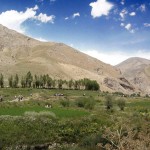So, for the upcoming symposium on Food I’m working on a paper about the hunting and, more importantly, butchering scenes of the bath house at Qusayr ‘Amra. The most affecting image shows two men holding an animal, probably an onager (a wild donkey) or an oryx upside down. The man on the left slits the throat of the animal while the man on the right forces a sword or spear into its flank. Bloods flows rather straightforwardly from the throat wound, but flame-like spurts of blood or entrails emerge from the other wound. The image immediately calls to mind modern regulations of animal slaughter necessary to produce halal or lawful food, based on material found in the Qur’an and the hadith. How exactly the slaughter depicted at Qusayr ‘Amra might relate to this material has yet to be fully explored, and this is only the first of several posts investigating the meanings of the scene.
Intentional Deaths
In the Qur’an itself, the primary concern is the purity of edible animals, which stems from the intentionality of the slaughter. Verse 5:3, for example, proscribes the consumption of animals the have not been slaughtered.
Prohibited to you are dead animals, blood, the flesh of swine, and that which has been dedicated to other than Allah , and [those animals] killed by strangling or by a violent blow or by a head-long fall or by the goring of horns, and those from which a wild animal has eaten, except what you [are able to] slaughter [before its death], and those which are sacrificed on stone altars, and [prohibited is] that you seek decision through divining arrows. Qur’an 5:3
Death by strangling, blunt trauma, a fall, or goring by another animal are unacceptable, but the actual technique of slaughter isn’t described (although the word used for slaughter, dhabihah, had a very precise meaning as we shall see shortly). The intentionality of the slaughter is important: believers can’t eat animals killed by wild animals, or animals slaughtered as a sacrifice to another (false) deity. These are either intentionless or improperly-intentioned kills, and therefore impure. Only animals intentionally slaughtered in dedication to Allah are considered edible. The next verse makes it clear that animals killed by trained hunting animals are considered edible as long as they are properly dedicated.
They ask you, [O Muhammad], what has been made lawful for them. Say, “Lawful for you are [all] good foods and [game caught by] what you have trained of hunting animals which you train as Allah has taught you. So eat of what they catch for you, and mention the name of Allah upon it, and fear Allah.” Qur’an 5:4
While this is an extremely pragmatic loophole, it has the effect of further emphasizing the importance of intentionality which extends from believers into the animals that they have trained to hunt. Intention is infectious, and spreads outward in a viral fashion from the believer via the process of training or domestication. The possibility of starvation leads to a further loophole found in 2:173 and 16:115.
He has only forbidden to you dead animals, blood, the flesh of swine, and that which has been dedicated to other than Allah . But whoever is forced [by necessity], neither desiring [it] nor transgressing [its limit], there is no sin upon him. Indeed, Allah is Forgiving and Merciful. Qur’an 2:173
He has only forbidden to you dead animals, blood, the flesh of swine, and that which has been dedicated to other than Allah . But whoever is forced [by necessity], neither desiring [it] nor transgressing [its limit] – then indeed, Allah is Forgiving and Merciful. Qur’an 16:115
It is permissible, if necessary, to consume that which is proscribed, because what really matters is intention.





